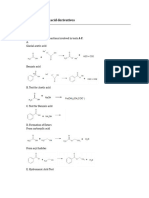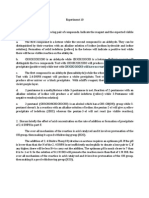Chem 28.1 E10 ATQ
Chem 28.1 E10 ATQ
Uploaded by
Sheenly Anne SaavedraCopyright:
Available Formats
Chem 28.1 E10 ATQ
Chem 28.1 E10 ATQ
Uploaded by
Sheenly Anne SaavedraCopyright
Available Formats
Share this document
Did you find this document useful?
Is this content inappropriate?
Copyright:
Available Formats
Chem 28.1 E10 ATQ
Chem 28.1 E10 ATQ
Uploaded by
Sheenly Anne SaavedraCopyright:
Available Formats
DETERMINATION OF PURITY AND ACID DISSOCIATION
CONSTANT OF POTASSIUM HYDROGEN PHTHALATE BY
POTENTIOMETRIC TITRATION
S.A.P. SAAVEDRA1, J. C. VILLASIS2
1
NATIONAL INSTITUTE OF PHYSICS, COLLEGE OF SCIENCE
2
DEPARTMENT OF FOOD SCIENCE AND NUTRITION, COLLEGE OF HOME ECONOMICS
UNIVERSITY OF THE PHILIPPINES, DILIMAN, QUEZON CITY, PHILIPPINES
DATE PERFORMED: JULY 5, 2016
INSTRUCTORS NAME: GARRERO, M.J.
1. What
are
the
significant
regions in the titration curve?
Relate the characteristics of
each region to the pH results
obtained.
Normal Titration Curve
Pre-equivalence point is the area
where the plot is concave up. A series
of weak acid buffer system determines
the pH of the solution (HA H+ + A-).
Equivalence point is represented by
the inflection point of the plot. It
indicates a rapid change in pH in a
small amount of volume. Hydrolysis of
the anion of the weak acid determines
the pH of the solution (predominating
species is A-).
Post-equivalence point is the area
where the plot is concave down.
Excess strong base determines the pH
of the solution (predominating species
are A- and OH-).
First and Second Derivative Curve
Through
extrapolation,
the
equivalence point can be obtained
from the first and second derivative
curve. Plotting the change of pH with
respect to volume forms the First
Derivative Curve. From the normal
curve, the equivalence point is when
the slope is maximum, thus, a spiked
curve should appear and its peak
representing the equivalence point.
Uncertainty arises, but can be avoided
by plotting a Second Derivative Curve
1
.
Mathematically,
the
second
derivative should pass through zero at
the equivalence point.
2. Why is continuous stirring
important in potentiometric
titration?
Continuous stirring is important in
order
to
keep
the
solution
homogeneous. It also ensures that the
change in pH detected by the pH
Page 1 of 5
meter accounts the whole pH of the
solution and not just the part nearest
the electrode.
3. Why should the increments of
addition of titrant be narrowed
down
as
the
titration
approaches the equivalence
point?
5. Discuss
possible
reasons
behind the discrepancies (if
any) in the experimental and
theoretical pKa values?
Note that at half-equivalence point,
A
. Thus, using activites, Ka
[ HA ]
becomes,
As the equivalence point is
approached, larger volumes of titrant
could affect the sharpness of the
curve. With smaller volumes, a better
curve with more accurate data points
can be taken 2.
H 3 O+
With potentiometric titrations, the
amount of volume of titrant used for
weak acids is the same as that of
strong ones since the number of
titratable protons is taken into
account,
and
not
the
actual
concentration. Potentiometric titration
deals with the potential between the
electrodes and relating the volume of
the titrant to the pH. It is also more
advantageous since it helps reduce
systematic
error
such
as
colorblindness.
a
A
H 3 O +
a
K a =
4. Why
is
potentiometry
a
suitable
method
for
determining pKa of weak acids?
Noting that weak acids do not
dissociate
completely,
normal
titrations involving physical indicators
are not as accurate as when used with
a strong acid-strong base reaction.
This is due to the formation of a weak
acid-strong base buffer that prevents
reaction to indicator and a change in
color.
A
HA
[1]
Since the glass electrode gives a
good
estimate
of
H 3 O+
,
a
the
difference between the measured pKa
and the theoretical pKa only comes
from the ratio of the activity
coefficient of A- to the activity
coefficient of HA 3.
exp
A
a K a HA
[2]
As
electrolyte
concentration
increases, the activity coefficient of HA
does not change significantly because
HA is a neutral species. However, the
activity coefficient of A- does decrease.
Page 2 of 5
This makes the
exp
a
metal ions
to increase and
the experimental pH to decrease. In
effect the experimental pKa is also
lower than the theoretical.
6. What are the possible sources
of errors and their effect on the
calculated
parameters?
Rationalize.
Some possible sources of error
throughout the experiment and their
effect on parameters are discussed in
Table 1 below.
TABLE 1. Possible Sources of
Errors and its Effect on Calculated
Parameters
Source of
Error
Dehydration
of electrode
Parameter and
Error
Causes
erratic
electrode
performance
and
having fluctuations in
pH reading.
Inaccuracy
of pH of the
standard
buffer
Inaccuracies
during
preparation, changes
during storage are
some of the cases
that make the pH of
the buffer erroneous,
thus
making
the
calibration erroneous
as well. Subsequent
pH measurements will
also be incorrect.
Alkaline
error
Gives a higher pH
reading at pH > 9 if
glass
electrode
respond
to
alkali
REFERENCES
[1]
Fattaleh, N. POTENTIOMETRIC
TITRATION OF A WEAK ACID, 2007.
http://web.clark.edu/nfattaleh/class
es/135/sp07/pottitrsp07.pdf
(accessed July 6, 2016).
[2] Nunag, I. G. J. POTENTIOMETRIC
DETERMINATION OF THE PURITY
AND DISSOCIATION CONSTANT OF
POTASSIUM
HYDROGEN
PHTHALATE; ATQ; Quezon City,
2015.
[3] Skoog, D. A. . W. D. M. . e. a.
Potentiometric
Titrations.
In
Fundamentals
of
Analytical
Chemistry, 8th ed.; Brooks/ColeThomson
Learning:
California,
2004; pp 623-627.
[4]
Page 3 of 5
Potentiometric Titration of an
Unknown Weak Monoprotic Acid,
2008. East Stroudsburg University.
http://www.asdlib.org/onlineArticles
/ecourseware/Gross_Potentiometry/
UnkAcidLab.pdf (accessed July 6,
2016).
Page 4 of 5
You might also like
- KLB Chem FORM 2Document170 pagesKLB Chem FORM 2Job Makori Ombui100% (4)
- Experiment 9 Relative Rates of Electrophilic Aromatic Substitution QuestionsDocument1 pageExperiment 9 Relative Rates of Electrophilic Aromatic Substitution QuestionsElah PalaganasNo ratings yet
- Chem31.1 ATQ12 Santos PDFDocument3 pagesChem31.1 ATQ12 Santos PDFClaire SantosNo ratings yet
- Optional Rotary Drilling Rig & Construction MethodDocument49 pagesOptional Rotary Drilling Rig & Construction MethodLinzaw WinNo ratings yet
- Damien Elite C-7Document3 pagesDamien Elite C-7m43238No ratings yet
- Organic Agave Syrup Technical Data SheetDocument4 pagesOrganic Agave Syrup Technical Data SheetEduardo LuboNo ratings yet
- Chem 28.1 E10 ATQDocument3 pagesChem 28.1 E10 ATQSheenly Anne SaavedraNo ratings yet
- C I E B: Ommon ON Ffect and UffersDocument3 pagesC I E B: Ommon ON Ffect and UffersDenise Dela CruzNo ratings yet
- Atq #10Document2 pagesAtq #10JoNo ratings yet
- Atq 4Document4 pagesAtq 4Martina BlasNo ratings yet
- Quantitative Analysis of Soda Ash by Double-Indicator TitrationDocument3 pagesQuantitative Analysis of Soda Ash by Double-Indicator TitrationSheenly Anne SaavedraNo ratings yet
- Aldehydes and Ketones: Answers To QuestionsDocument3 pagesAldehydes and Ketones: Answers To Questionsmark pascuaNo ratings yet
- ATQ 6 Chem 28.1Document2 pagesATQ 6 Chem 28.1ho-humhumdrumNo ratings yet
- ATQDocument2 pagesATQCamille QuiñonesNo ratings yet
- Experiment 9 Atq PDFDocument12 pagesExperiment 9 Atq PDFBea Francesca SosaNo ratings yet
- Relative Rates of Electrophilic Aromatic SubstitutionDocument2 pagesRelative Rates of Electrophilic Aromatic SubstitutionMatthew ColeNo ratings yet
- Experiment 1 - ATQDocument2 pagesExperiment 1 - ATQAndrea Nicole RocafortNo ratings yet
- Quantitative Determination of Soda Ash Composition by Double Indicator TitrationDocument2 pagesQuantitative Determination of Soda Ash Composition by Double Indicator TitrationAlexander Gordon InesNo ratings yet
- Expt. #4 - RDRDocument7 pagesExpt. #4 - RDRClarice Mae DacasinNo ratings yet
- Chem 31 AtqE1Document3 pagesChem 31 AtqE1Anonymous GO6JVW9WudNo ratings yet
- Common Ion Effect and Buffers AtqDocument2 pagesCommon Ion Effect and Buffers AtqPancho VillamoranNo ratings yet
- Quantitative Determination of Total Hardness in Drinking Water by Complexometric EDTA TitrationDocument14 pagesQuantitative Determination of Total Hardness in Drinking Water by Complexometric EDTA Titrationabcd efgNo ratings yet
- Atq Exp11Document3 pagesAtq Exp11Camille GrefaldiaNo ratings yet
- Chem 31.1 Expt 8 Lab ReportDocument30 pagesChem 31.1 Expt 8 Lab ReportJohn Christian LopezNo ratings yet
- CHEM31.1 ATQ3 SantosDocument2 pagesCHEM31.1 ATQ3 SantosClaire SantosNo ratings yet
- ATQ-1 Solubility of Organic CompoundsDocument2 pagesATQ-1 Solubility of Organic CompoundsAnne Raever BenavidezNo ratings yet
- Experiment 4 Results and Discussion Report: Common Ion-Effect and BuffersDocument2 pagesExperiment 4 Results and Discussion Report: Common Ion-Effect and BuffersNathalie Dagmang67% (3)
- (Ablang) Experiment 4 AtqDocument2 pages(Ablang) Experiment 4 AtqAbi ANo ratings yet
- Expt. 8 Chem 26.1Document3 pagesExpt. 8 Chem 26.1Jeannelle TanNo ratings yet
- Chem 31.1 Exp 10Document2 pagesChem 31.1 Exp 10qwertyuasiop100% (1)
- Common Ion Effect and Buffers: M. de LeonDocument8 pagesCommon Ion Effect and Buffers: M. de LeondeleonmatthewreiNo ratings yet
- Chem26.1 ATQ Exp11 21718Document2 pagesChem26.1 ATQ Exp11 21718Alexander Gordon InesNo ratings yet
- Experiment 4: Common-Ion Effect and Buffers Ignatius Dominic P. Cumigad College of ScienceDocument2 pagesExperiment 4: Common-Ion Effect and Buffers Ignatius Dominic P. Cumigad College of ScienceJemimahNo ratings yet
- ATQ4Document2 pagesATQ4Julius Alfredo ViloriaNo ratings yet
- Nucleophilic Acyl Substitution Chem 31Document5 pagesNucleophilic Acyl Substitution Chem 31Frances Abegail QuezonNo ratings yet
- Chem 31.1 Expt 1. SolubilityDocument3 pagesChem 31.1 Expt 1. SolubilityBuiHope100% (2)
- Chem 28 Problem Set 2Document1 pageChem 28 Problem Set 2Anonymous ee5dOjNo ratings yet
- UP CHEM 31 Carboxylic Acids and Acid DerivativesDocument3 pagesUP CHEM 31 Carboxylic Acids and Acid DerivativesZsara CampanoNo ratings yet
- Problemas 6.11Document7 pagesProblemas 6.11Anna SalinasNo ratings yet
- EXPERIMENT 5 Common Ion EffectDocument4 pagesEXPERIMENT 5 Common Ion EffectNat DabuétNo ratings yet
- Relative Rates of Electrophilic Aromatic SubstitutionDocument2 pagesRelative Rates of Electrophilic Aromatic SubstitutionAnonymous GO6JVW9Wud100% (4)
- Atq Experiment 8 Chem 26.1Document7 pagesAtq Experiment 8 Chem 26.1Rei Diaz Apalla100% (1)
- Department of Chemical Engineering, University of The Philippines, Diliman, Quezon CityDocument2 pagesDepartment of Chemical Engineering, University of The Philippines, Diliman, Quezon CityElaine Nicole CanebaNo ratings yet
- Nucleophlic Acyl Substitution - The Synthesis of Ethyl ButanoateDocument5 pagesNucleophlic Acyl Substitution - The Synthesis of Ethyl ButanoateRuther Cabral67% (3)
- Determination of Electrode PotentialsDocument2 pagesDetermination of Electrode PotentialsTatocatNo ratings yet
- Atq E6Document2 pagesAtq E6BuiHopeNo ratings yet
- ATQ: Experiment #8Document3 pagesATQ: Experiment #8JoNo ratings yet
- Chem 26.1 DataDocument2 pagesChem 26.1 Datagamingonly_accountNo ratings yet
- Chem 31 PROCEDURES (Practicals)Document9 pagesChem 31 PROCEDURES (Practicals)FMDCNo ratings yet
- Recrystallization and Melting Point Determination of Benzoic AcidDocument6 pagesRecrystallization and Melting Point Determination of Benzoic AcidAnonymous GO6JVW9Wud0% (1)
- Aldehydes and KetonesDocument1 pageAldehydes and KetonesThea Mae Dino0% (1)
- FR 1 (E6)Document5 pagesFR 1 (E6)JR CastorNo ratings yet
- Midterm Exam Reviewer (Mas Malala Talaga Ang Real Exam)Document3 pagesMidterm Exam Reviewer (Mas Malala Talaga Ang Real Exam)Ying YangNo ratings yet
- Chem 26 1 Midterms ReviewDocument15 pagesChem 26 1 Midterms ReviewAlyzza Victoria TorresNo ratings yet
- Determination of The Solubility Product Constant of Calcium Hydroxide Chem 17Document7 pagesDetermination of The Solubility Product Constant of Calcium Hydroxide Chem 17Frances Abegail QuezonNo ratings yet
- Experiment 5 Chem 26.1Document2 pagesExperiment 5 Chem 26.1Collin Reyes HuelgasNo ratings yet
- Chem 26.1 Ex. 12Document2 pagesChem 26.1 Ex. 12Jo FernandezNo ratings yet
- Chem 26.1 Experiment 11 Formal ReportDocument6 pagesChem 26.1 Experiment 11 Formal ReportMary Joyce100% (1)
- Aliphatic and Aromatic HydrocarbonsDocument1 pageAliphatic and Aromatic HydrocarbonsJulian Bato0% (3)
- Synthesis of Alkyl HalideDocument3 pagesSynthesis of Alkyl HalideKelvin LabarezNo ratings yet
- Synthesis of An Alkyl HalideDocument4 pagesSynthesis of An Alkyl HalideJoseph CatiisNo ratings yet
- Experiment 10 - Quantitative Determination of The Purity and Dissociation of Potassium Hydrogen Phthalate by Potentiometric Titration AtqDocument3 pagesExperiment 10 - Quantitative Determination of The Purity and Dissociation of Potassium Hydrogen Phthalate by Potentiometric Titration AtqDoom RefugeNo ratings yet
- Potentiometric Determination of The Purity and Dissociation Constant of Potassium Hydrogen Phthalate Chem 28Document3 pagesPotentiometric Determination of The Purity and Dissociation Constant of Potassium Hydrogen Phthalate Chem 28Frances Abegail QuezonNo ratings yet
- Expt.1 BiochemDocument4 pagesExpt.1 BiochemMc de RamosNo ratings yet
- Astm C1396 C1396M 17Document6 pagesAstm C1396 C1396M 17carineNo ratings yet
- Effect of Sleep Deprivation in Memory Retention and Analytical SkillsDocument16 pagesEffect of Sleep Deprivation in Memory Retention and Analytical SkillsSnow VilaverdeNo ratings yet
- SRP3A - MEB - RFI 0572 - MEB Anchor Plate Frictional Force - Response REV 1Document44 pagesSRP3A - MEB - RFI 0572 - MEB Anchor Plate Frictional Force - Response REV 1mirza.adeelNo ratings yet
- Physical PropertiesDocument17 pagesPhysical Propertiesjaime1234No ratings yet
- BAGHDAd The Lost CityDocument5 pagesBAGHDAd The Lost CitySiddharth MNo ratings yet
- Urban GardeningDocument28 pagesUrban GardeningENANO Jayryl D.No ratings yet
- Excerpt Poems Elizabeth BishopDocument5 pagesExcerpt Poems Elizabeth BishopKaline Dos Santos SoaresNo ratings yet
- Operating Instructions: R2E220-AA40-23Document9 pagesOperating Instructions: R2E220-AA40-23Leszek PuchalaNo ratings yet
- Phonics Screening Check HomeworkDocument7 pagesPhonics Screening Check Homeworkafnawepeaavrlj100% (1)
- 90210-1241DEF - Conveyor Synchronization 1SQ Board Hardware Manual (D, E Series)Document28 pages90210-1241DEF - Conveyor Synchronization 1SQ Board Hardware Manual (D, E Series)alessandroNo ratings yet
- Jerusalem ArtichokeDocument16 pagesJerusalem ArtichokeceramickurtNo ratings yet
- Hydrahib PsDocument1 pageHydrahib Pswaleed mosalamNo ratings yet
- Name: Ghina Athiyyaturrahmah Class: 2B NPM: 200202035 MK: Writing For General Com. Tugas 1Document2 pagesName: Ghina Athiyyaturrahmah Class: 2B NPM: 200202035 MK: Writing For General Com. Tugas 1Nurpazila PBINo ratings yet
- 12 of The Most Empowering Iyanla Vanzant Quotes On LifeDocument16 pages12 of The Most Empowering Iyanla Vanzant Quotes On Lifeselva100% (4)
- Science Installing Windows 7Document24 pagesScience Installing Windows 7maria naragNo ratings yet
- Difference Between Batch Input and Session Call TransactionDocument1 pageDifference Between Batch Input and Session Call TransactionseventhhemanthNo ratings yet
- Sr. No. Description Unit Quantity Offered Make Inteliigent Addressable Fire Detection SystemDocument4 pagesSr. No. Description Unit Quantity Offered Make Inteliigent Addressable Fire Detection SystemShekhar1562No ratings yet
- Galvanic CellsDocument4 pagesGalvanic CellsshariziNo ratings yet
- CH 8 Ethics TechnologyDocument11 pagesCH 8 Ethics Technologychfgvjkl;No ratings yet
- FEC Standard: Hardware DescriptionDocument134 pagesFEC Standard: Hardware DescriptionikarosNo ratings yet
- Cold Chain System and Adverse Reaction Following Immunization (Aefi)Document46 pagesCold Chain System and Adverse Reaction Following Immunization (Aefi)Shikya AbnasNo ratings yet
- MLF Week 11 Ga (Part II)Document7 pagesMLF Week 11 Ga (Part II)Krishna ParikhNo ratings yet
- PDF Hypothesis Testing Random Motors Project DDDocument6 pagesPDF Hypothesis Testing Random Motors Project DDPrathamesh ShettyNo ratings yet
- Machine Learning Prediction in Cardiovascular Diseases: A Meta AnalysisDocument11 pagesMachine Learning Prediction in Cardiovascular Diseases: A Meta AnalysisClaudiu ClementNo ratings yet
- Thermodynamics WorksheetDocument9 pagesThermodynamics Worksheetdizzy057765No ratings yet
- B.Tech R20 III Year ECE Model Papers FINAL ws-16-23Document8 pagesB.Tech R20 III Year ECE Model Papers FINAL ws-16-23Bandaru Jaswanth kumarNo ratings yet

























































































